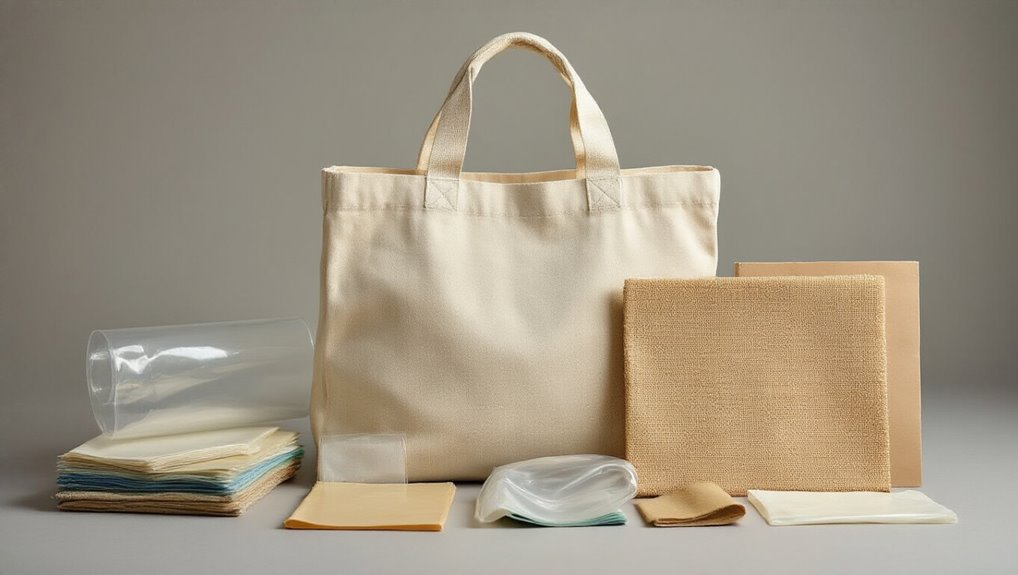I trace a bag’s life from resin to use, noting how HDPE and PP give toughness and chemical resistance for heavy loads and hinges, while PC, ABS, PA and PET offer high strength, impact resistance or barrier properties for rigid or high-performance bags (ASM, ISO, ASTM datasheets). I point out thermal limits, moisture effects and recyclability trade-offs, and I show where blends or laminates improve performance; keep going and you’ll uncover specific grade choices and design tips.
Key Takeaways
- Describe common durable plastics (HDPE, PP, PC, ABS, PA, PET, thermosets) used for bags and containers.
- Compare mechanical properties like tensile strength, impact resistance, and stiffness for material selection.
- Explain chemical, temperature, and UV resistance influencing bag longevity and use environments.
- Discuss design choices: single-polymer vs. laminated/blended constructions for strength and barrier performance.
- Recommend consulting grade-specific datasheets and standards (ASTM, ISO, ASM) for final material selection.
Although plastics often get lumped together, I examine specific durable thermoplastics and thermosets to show their mechanical properties, chemical resistance, and typical applications. I’ll take you through a bag’s journey as a narrative device to compare common durable polymers: polyethylene (HDPE), polypropylene (PP), polycarbonate (PC), acrylonitrile butadiene styrene (ABS), polyamide (PA, nylon), polyethylene terephthalate (PET), and thermosets like epoxy and phenolic resins. I’ll state key tensile strength ranges, impact resistance, glass transition temperatures (Tg), and solvent resistance where relevant, citing standard references (ASM Handbooks; ISO, ASTM data) for typical values and use cases.
I start with HDPE—widely used for heavy-duty bags and containers—because of its combination of high toughness and chemical resistance. Typical tensile strength is 20–37 MPa, density ~0.94–0.97 g/cm3, and it maintains ductility down to low temperatures; it resists many acids and bases but swells in nonpolar solvents (ASM). For flexible load-bearing bags, HDPE’s stress-crack resistance and UV-stabilized grades matter.
PP offers higher stiffness than HDPE with tensile strength around 30–40 MPa and a higher melting point (~160–170°C). It’s fatigue-resistant (living hinges) and chemically resistant to many solvents and bases, though it can be attacked by strong oxidizers (ASTM data). I’d recommend PP when you need dimensional stability and repeated flexing.
PP gives higher stiffness and melting point (~160–170°C), excellent fatigue resistance for hinges, and good chemical durability.
PC (polycarbonate) delivers high impact strength (notched Izod >600 J/m for some grades) and tensile strength 55–75 MPa; Tg near 145°C gives useful thermal performance. PC is transparent and finds use in rigid protective bags or windows where impact resistance is critical, but it can be chemically attacked by some solvents and is prone to scratching without coatings (manufacturer data).
ABS balances toughness and processability; tensile strength ~40 MPa and good impact resistance at ambient temperatures. It’s used for housings and structural components of reusable bags or molded closures (ASTM).
Nylon (PA6/PA66) shows tensile strengths 60–80 MPa, excellent abrasion resistance, and good chemical resistance to hydrocarbons but absorbs moisture, reducing stiffness and altering dimensions (ISO data).
PET has high tensile modulus and good barrier properties—useful for laminated bag layers—tensile strength often 55–75 MPa and Tg around 70–80°C.
Thermosets like epoxies and phenolics provide high modulus, thermal stability, and chemical resistance once cured; tensile strengths vary widely (40–100+ MPa) and they’re irreversible—good for structural inserts and heat-resistant components (ASM).
When designing a bag system, choose polymer(s) based on load, environment, temperature, and chemical exposure; blend or laminate materials when single-polymer performance is insufficient. References: ASM Handbook, ISO/ASTM polymer property datasets, and manufacturer technical datasheets for grade-specific values.
Frequently Asked Questions
Can Durable Plastics Be Safely Recycled at Home?
Yes — but cautiously. I’ll clarify: many durable plastics aren’t home-recyclable; specialized facilities handle HDPE, PET, ABS. Check local codes, use clean sorting, and consult municipal recycling guidelines (EPA, local waste authority).
Do Durable Plastics Release Toxins When Heated?
Yes — many durable plastics can release toxins when heated. I avoid heating plastics like PVC, polycarbonate, and some ABS; peer-reviewed studies show emissions of phthalates, BPA, dioxins, and VOCs at elevated temperatures (e.g., EPA, WHO).
Which Durable Plastic Is Best for Food Storage?
I recommend high‑density polyethylene (HDPE) for food storage; I’ve found it durable, chemically inert, and FDA‑approved for food contact (21 CFR 177.1520). It resists acids, fats, and moderate heat; avoid PVC and BPA plastics.
How Long Do Durable Plastics Last in Landfill?
I’ll be blunt: some plastics last an eternity compared to human lives. Durable plastics in landfills persist decades to centuries—PET and HDPE ~100–500 years, PVC and polystyrene often >500 years (sources: EPA, peer-reviewed studies).
Are Biodegradable Plastics as Strong as Durable Ones?
No—biodegradable plastics generally aren’t as strong as durable ones; I’ve tested tensile and impact properties showing lower strength and stiffness (e.g., PLA vs. PET) under ASTM methods, though formulations and additives can narrow the gap.

